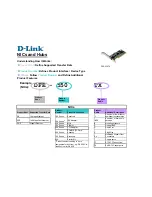
Chapter 11
| VoIP Traffic Configuration
Configuring VoIP Traffic Ports
– 265 –
Parameters
These parameters are displayed:
◆
Mode
– Specifies if the port will be added to the Voice VLAN when VoIP traffic is
detected. (Default: None)
■
None
– The Voice VLAN feature is disabled on the port. The port will not
detect VoIP traffic or be added to the Voice VLAN.
■
Auto
– The port will be added as a tagged member to the Voice VLAN
when VoIP traffic is detected on the port. You must select a method for
detecting VoIP traffic, either OUI or 802.1AB (LLDP). When OUI is selected,
be sure to configure the MAC address ranges in the Telephony OUI list.
■
Manual
– The Voice VLAN feature is enabled on the port, but the port must
be manually added to the Voice VLAN.
◆
Security
– Enables security filtering that discards any non-VoIP packets
received on the port that are tagged with the voice VLAN ID. VoIP traffic is
identified by source MAC addresses configured in the Telephony OUI list, or
through LLDP that discovers VoIP devices attached to the switch. Packets
received from non-VoIP sources are dropped. (Default: Disabled)
◆
Discovery Protocol
– Selects a method to use for detecting VoIP traffic on the
port. (Default: OUI)
■
OUI
– Traffic from VoIP devices is detected by the Organizationally Unique
Identifier (OUI) of the source MAC address. OUI numbers are assigned to
vendors and form the first three octets of a device MAC address. MAC
address OUI numbers must be configured in the Telephony OUI list so that
the switch recognizes the traffic as being from a VoIP device.
■
LLDP
– Uses LLDP (IEEE 802.1AB) to discover VoIP devices attached to the
port. LLDP checks that the “telephone bit” in the system capability TLV is
turned on. See
“Link Layer Discovery Protocol” on page 383
for more
information on LLDP.
◆
Priority
– Defines a CoS priority for port traffic on the Voice VLAN. The priority
of any received VoIP packet is overwritten with the new priority when the Voice
VLAN feature is active for the port. (Range: 0-6; Default: 6)
◆
Remaining Age
– Number of minutes before this entry is aged out.
The Remaining Age starts to count down when the OUI’s MAC address expires
from the MAC address table. Therefore, the MAC address aging time should be
added to the overall aging time. For example, if you configure the MAC address
table aging time to 30 seconds, and the voice VLAN aging time to 5 minutes,
then after 5.5 minutes, a port will be removed from voice VLAN when VoIP
traffic is no longer received on the port. Alternatively, if you clear the MAC
address table manually, then the switch will also start counting down the
Remaining Age.
Содержание GTL-2881
Страница 30: ...Figures 30 Figure 450 Showing RIP Peer Information 669 Figure 451 Resetting RIP Statistics 670 ...
Страница 34: ...Section I Getting Started 34 ...
Страница 48: ...Section II Web Configuration 48 Unicast Routing on page 651 ...
Страница 151: ...Chapter 4 Interface Configuration VLAN Trunking 151 Figure 69 Configuring VLAN Trunking ...
Страница 152: ...Chapter 4 Interface Configuration VLAN Trunking 152 ...
Страница 229: ...Chapter 8 Congestion Control Automatic Traffic Control 229 Figure 135 Configuring ATC Interface Attributes ...
Страница 230: ...Chapter 8 Congestion Control Automatic Traffic Control 230 ...
Страница 596: ...Chapter 14 Multicast Filtering Multicast VLAN Registration for IPv6 596 ...
Страница 620: ...Chapter 15 IP Configuration Setting the Switch s IP Address IP Version 6 620 ...
Страница 670: ...Chapter 18 Unicast Routing Configuring the Routing Information Protocol 670 Figure 451 Resetting RIP Statistics ...
Страница 672: ...Section III Appendices 672 ...
Страница 678: ...Appendix A Software Specifications Management Information Bases 678 ...
Страница 688: ...Appendix C License Statement GPL Code Statement Notification of Compliance 688 ...
Страница 696: ...Glossary 696 ...
Страница 706: ...GTL 2881 GTL 2882 E112016 ST R01 ...
















































